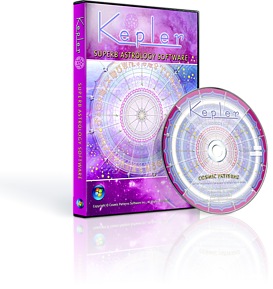
|
KEPLER 3.0 (Astrology Program for IBM Compatible Computers) NOTE: The following review appeared in the July, 1997 issue of Dell Horoscope magazine. The review is well-done. The current version of Kepler for computers with Windows 8 and a CD-ROM drive is 7.0, much improved over the version reviewed here just a few months ago. More about Kepler 7.0 >

Now that you've got a computer, it's time to shop for some astrology software. But which one to buy? Several nationally marketed astrology programs will do the basic job for anywhere between $150 and $300, and as you decide to add on interpretive reports or specific calculation features, the cost can double and triple in no time at all. Each of the major software designers has built in certain attractive features to outdistance the competition, and you have to decide which one is most compatible to your own needs. Kepler 3.0 for Windows 3.1 (or Kepler 4.0 for Windows 95) certainly deserves your highest consideration. Kepler's strength lies in its user-friendly design and its inclusion of the ACS Atlas and time zone changes in the basic program price of $200. Another big plus are the Cosmos reports which offer accurate interpretations as printout options, These essential beginner's tools make Kepler 3.0 a top choice for new buyers. For researchers and professionals, Kepler's search modules and add-on interpretive reports provide a solid vehicle for your finest hours. The user-friendliness of Kepler 3.0 comes from its natural intuitive approach to creating and printing charts. To get you started, the User's Manual has five pages of "What you really need to know,"from which you can learn everything about generating your first chair, and Cosmo reports. Also included with the eight disks is a demo disk, which takes the new user through the simple step-by-step procedure to entering data, and then getting printouts. For anyone already familiar with Windows 3.1, the process is straight-forward and easy. Perhaps the most impressive strength of Kepler 3.0 is its extensive atlas and time changes database. For both beginners and professionals, the erratic time zone changes in the United States and internationally are a major hurdle to generating accurate charts. Typically, to find out which time zone was in effect, and whether the locale was on Daylight Saving Time, requires a stop-andsearch-the-references approach. Kepler 3.0 automatically enters the longitude and latitude for you once the city is selected. And then the correct time zone and DST factor are also automatically entered, saving you from potentially embarrassing errors, not to mention the savings in look-up time. The three Cosmo reports included with Kepler 3.0 (natal, compatibility, and forecast) are simple but elegant features which take the calculations side into a whole new dimension. Along with an accurate chart, the user can select any one of these three Cosmo reports to be included in the printouts. The Cosmo Natal report focuses on interpretihg the personal planets and Ascendant by sign and major aspect (though not by house), and generally amounts to around 68 pages of printed material. The Cosmo Transit report describes the effects of transiting Sun, Mercury, Venus, and Mars to your natal chart, leaving out the heavy-hitter outer planets. The most interesting in its interpretive information seems to be the Cosmo Compatibility report, which sounds authoritative in tone, and accurate in the impression it leaves. Cosmic Patterns, the software company behind Kepler, is especially user-friendly to astrologers who want to design their own interpretive reports. In the demo disk, Kepler displays samples of other reports available as add-ons, ranging in price from $50-$300. Here's where you'll find in-depth analyses on a wide range of topics for your charts stored on Kepler 3. 0. Under health reports, you can choose from a $50 Cosmobiology program, or from three other, more detailed and accurate $200 programs describing various medical conditions and forecasts. Other programs can be found for various natal interpretations, forecast interpretations, relocation, vocational guidance, past lives, children, flower essences and gems, and so on. And then, all these reports may inspire you to write your own specialized interpretive program, for which Kepler will pay you a handsome royalty! Kepler is updated about every 4-6 months. On the drawing board for upcoming versions are fixed star conjunctions, planetary returns, and a more extensive asteroid set beyond the four major asteroids included with version 3.0. My one (minor) recommendation for the designers is that a colorful opening screen be included in the next version. The stony gray, graphically empty, first image doesn't do justice to the inner workings. Aesthetically, Kepler needs a face-lift. But conceptionally, the outstanding calculation and interpretive resources make this software a best bet.
|
